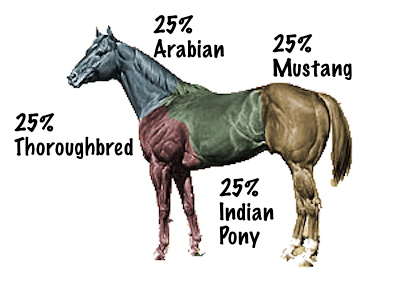“There are many theories of the lineage of the QuarterHorse. The best known is the fact that this breed is so proficient in short burst of speed i.e. the quarter mile that, the name Quarter Horse came about. Many years ago, I read that this breed was so called because, in the initial bloodlines, they were one-quarter Arabian. Do you have any input on this? I Enjoy reading about your work..P.J.G.”
The AQHA has always promoted that the term “Quarter” refers to the distance, a quarter of a mile, that was popular for match racing with the early ‘Quarter’ horses.
You question about the bloodlines is interesting though. On the surface your 25% Arabian would fit (loosely) with the idea that the breed was made up from breeding Indian ponies (Spanish Barbs) to Arabians, adding in Thoroughbred and mixing in some mustang. But how would you figure out the percentages?
- 25% Chickasaw Indian ponies-which were Spanish Barbs
- 25% Arabian-specifically Janus, a grandson of The Godolphin Arabian who was imported in 1752 and bred to the Chickasaw ponies
- 25% Thoroughbred-Sir Archy
- 25% Mustang
However, can you imagine the nightmare if these hard numbers were argued about? For example, I would ask the question: Where did the mustangs come from? Aren’t Thoroughbreds descended from Arabians so the Arabian blood should be a higher percentage?
You might be correct on both parts- at least if we look at it in general. I found a wonderful article on the AQHA Breed History that goes into quite a bit of detail. I suggest you read it if you want the full account.
9 Comments
Leave a Comment

FREE PDF DOWNLOAD
WHY IS MY HORSE...?
100% Private - 0% Spam
No one taught you the skills you need to work through these things.
Riders often encounter self-doubt, fear, anxiety, frustration, and other challenging emotions at the barn. The emotions coursing through your body can add clarity, or can make your cues indistinguishable for your horse.
Learning these skills and begin communicating clearly with your horse.
Click here to learn more.

Just FYI to anyone interested. I just found the answer to my previous question to anyone interested.
Below is the link.
http://www.nfqha.com/index_files/page4.htm
I have a question about how all this affects if your QH can be considered a “foundation” horse. If all these different breeds contributed to what would become our beloved QH, why does a Thoroughbred in their lineage past 1940 lessen the “foundation” percentage? I’ve just started researching all of this because I’m trying to see if my horse falls in the percentage that allows him to be registered as such.
It is an interesting question, one that the Foundation Association will have to answer for you.
Thank you Stacy, I will have to do that.
In the (roughly) 1760’s Americans raced their cow ponies over the distance of a quarter mile, giving rise the the name for the quarter horse. Many different horse breeds are influenced by arabian blood.
Love love love that you mentioned Spanish Barbs! I have one who is a grullo. He was part of a breeding program to bring the breed back as close to the original as possible. He just turned 32 years old in April and has been my constant companion for 15 years. Most folks don’t know what a Spanish Barb is so thanks for spreading the word. BTW – this horse has the BEST feet due to his breeding and lineage – 2 abcesses in 32 years.
hi Stacy, this is what I wrote about as you asked to upgrade your news letter, I suggested putting in a “Horse 0f the Month” and give a semi-detailed history about the horse. I think a lot of people would be interested in learning about certain horses. I LOVE what you did and are still doing with your darling JAC!!!
They are known as “cuarto de milla” in Spanish speaking South America and “quarto de milha” in Brazil, I think Brazil has the largest population of registered Quarter horses after the States.
Great article…. thanks…